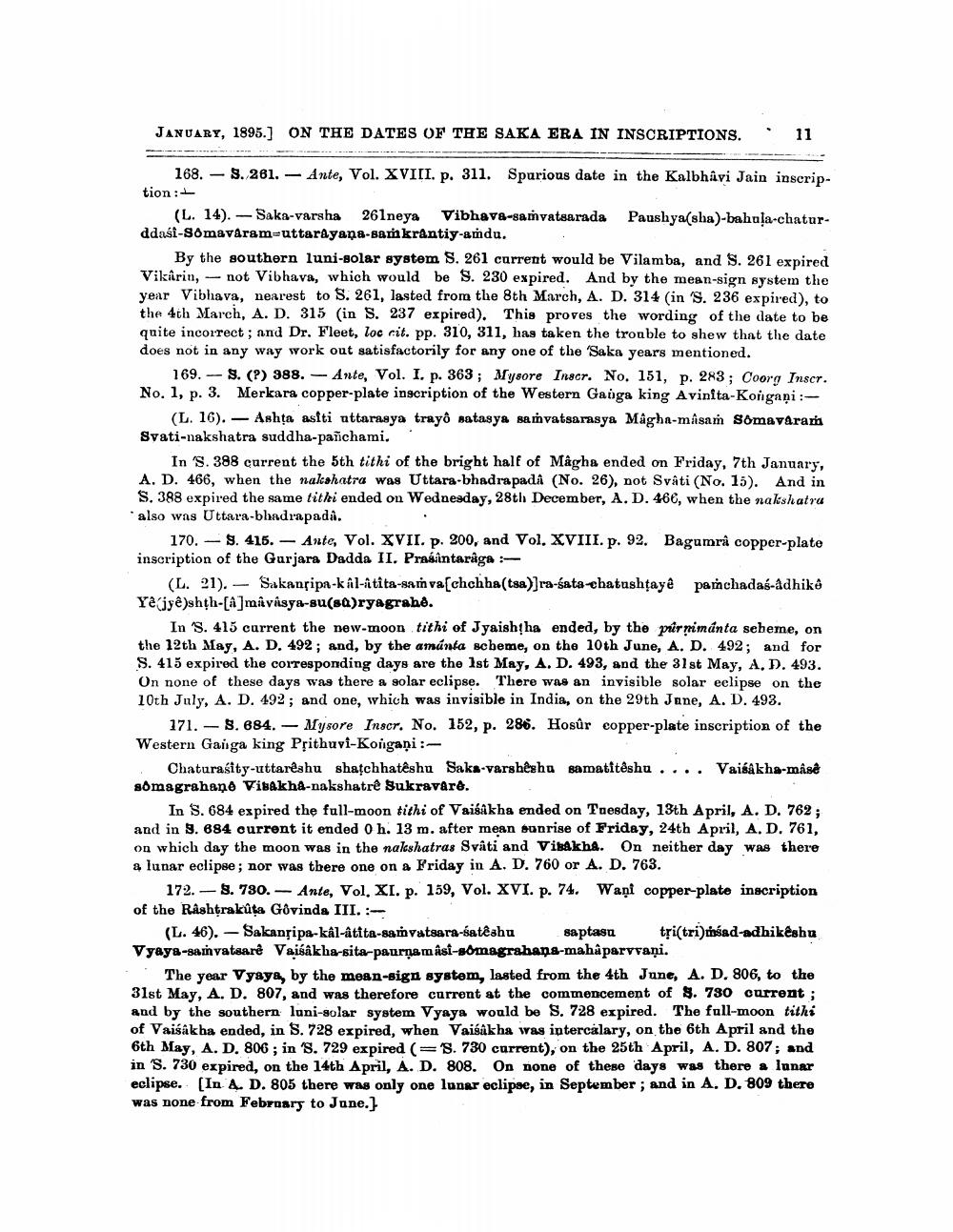________________
JANUARY, 1895.) ON THE DATES OF THE SAKA ERA IN INSCRIPTIONS.. 11
168. - S. 261. - Ante, Vol. XVIII. p. 311. Spurious date in the Kalbhavi Jain inscription:
(L. 14). - Saka-varsha 261neya Vibhava-samvatsarada Paushya(sha)-bahula-chaturddasi-Somavaram-uttarayana-samkrantiy-amdu.
By the southern luni-solar system S. 261 current would be Vilamba, and S. 261 expired Vikarin, -not Vibhava, which would be S. 230 expired. And by the mean-sign system the year Vibhava, nearest to S. 261, lasted from the 8th March, A. D. 314 (in 'S. 236 expired), to the 4th March, A. D. 315 (in S. 237 expired). This proves the wording of the date to be quite incorrect; and Dr. Fleet, loc cit. pp. 310, 311, has taken the trouble to shew that the date does not in any way work out satisfactorily for any one of the 'Saka years mentioned.
169. - S. (?) 388. - Ante, Vol. I. p. 363; Mysore Inscr. No. 151, p. 283; Coorg Inscr. No. 1, p. 3. Merkara copper-plate inscription of the Western Gaiga king Avinita-Kongani:
(L. 16). — Ashta asiti uttarasya trayô satasya samvatsarasya Magha-masam Somavara Svati-nakshatra suddha-panchami.
In 'S. 388 current the 5th tithi of the bright half of Mâgha ended on Friday, 7th January, A. D. 466, when the naloshatra was Uttara-bhadrapada (No. 26), not Svâti (No. 15). And in S. 388 expired the same tithi ended on Wednesday, 28th December, A. D. 466, when the nakshatra also was Uttara-bhadrapada.
170. - 9. 415. - Ante, Vol. XVII. p. 200, and Vol. XVIII. p. 92. Bagumrå copper-plate inscription of the Gurjara Dadda II. Prasintarága :
(L. 21). - Sakanripa-kal-atita-samva(chchha(tsa)]ra-sata-chatushtayé parchadas-adhiko Yetiyê)shth-[@]mavasya-su(sa)ryagrahe.
In 'S. 415 current the new-moon tithi of Jyaishịha ended, by the pirmimánta seheme, on the 12th May, A. D. 492; and, by the amánta scheme, on the 10th June, A. D. 492; and for S. 415 expired the corresponding days are the 1st May, A. D. 493, and the 31st May, A.D. 493. On none of these days was there a solar eclipse. There was an invisible solar eclipse on the 10th July, A. D. 492; and one, which was invisible in India, on the 29th June, A. D. 493.
171. – 3. 684. – Mysore Inscr. No. 152, p. 286. Hosûr copper-plate inscription of the Western Ganga king Prithuvi-Kongani:
Chaturasity-uttaréshu shatch hatêshu Saka-varsheghu samatitêshu .... Vaisakha-masê somagrahaņo Vibakha-nakshatré Sukravare.
In S. 684 expired the full-moon tithi of Vaisakha ended on Tuesday, 13th April, A. D. 762 ; and in 9. 684 surrent it ended 0 h. 13 m. after mean sunrise of Friday, 24th April, A.D. 761, on which day the moon was in the naloshatras Svâti and Vibakha. On neither day was there a lunar eclipse; nor was there one on a Friday in A. D. 760 or A. D. 763.
172. - 3.780. - Ante, Vol. XI. p. 159, Vol. XVI. p. 74. Wani copper-plate inscription of the Rashtrakūta Govinda III. :
(L. 46). – Sakanripa-kal-atita-samvatsara-satêahu saptasu tri(tri)msad-adhikeshu Vyaya-samvatsaré Vaisakha-sita-paurnamasi-somagrahang-mahậparvrani.
The year Vyaya, by the mean-Bign system, lasted from the 4th June, A. D. 806, to the 31st May, A. D. 807, and was therefore current at the commencement of $. 730 current ; and by the southern luni-solar system Vyaya would be S. 728 expired. The full-moon tithi of Vaisakha ended, in S. 728 expired, when Vaisakha was intercalary, on the 6th April and the 6th May, A. D. 806 ; in 'S. 729 expired (='S. 730 current), on the 25th April, A. D. 807; and in S. 730 expired, on the 14th April, A. D. 808. On none of these days was there a lunar eclipse. (In 4. D. 805 there was only one lunar eclipse, in September; and in A, D, 809 there was none from February to June.]




